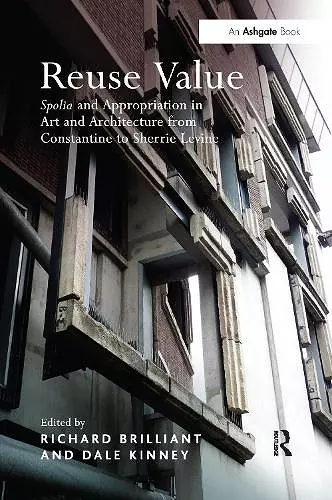Reuse Value
Spolia and Appropriation in Art and Architecture from Constantine to Sherrie Levine
Richard Brilliant editor Dale Kinney editor
Format:Paperback
Publisher:Taylor & Francis Ltd
Published:9th Sep '16
Currently unavailable, and unfortunately no date known when it will be back
This paperback is available in another edition too:
- Hardback£150.00(9781409424222)

This book offers a range of views on spolia and appropriation in art and architecture from fourth-century Rome to the late twentieth century. Using case studies from different historical moments and cultures, contributors test the limits of spolia as a critical category and seek to define its specific character in relation to other forms of artistic appropriation. Several authors explore the ethical issues raised by spoliation and their implications for the evaluation and interpretation of new work made with spolia. The contemporary fascination with spolia is part of a larger cultural preoccupation with reuse, recycling, appropriation and re-presentation in the Western world. All of these practices speak to a desire to make use of pre-existing artifacts (objects, images, expressions) for contemporary purposes. Several essays in this volume focus on the distinction between spolia and other forms of reused objects. While some authors prefer to elide such distinctions, others insist that spolia entail some form of taking, often violent, and a diminution of the source from which they are removed. The book opens with an essay by the scholar most responsible for the popularity of spolia studies in the later twentieth century, Arnold Esch, whose seminal article 'Spolien' was published in 1969. Subsequent essays treat late Roman antiquity, the Eastern Mediterranean and the Western Middle Ages, medieval and modern attitudes to spolia in Southern Asia, the Italian Renaissance, the European Enlightenment, modern America, and contemporary architecture and visual culture.
'... presents a wide spectrum and diverse perspectives... This book would make an interesting addition to any reading list... Recommended.' Choice 'Richard Brilliant and Dale Kinney, as indefatigable pioneers in the field of spolia-studies, have inspired many colleagues to think and rethink their positions and notions; this collection of essays attests to that inspiration. As with many such volumes this book does not present one theme or one line of thought which other scholars can use, but the chapters are showcases for specific problems, inducing the reader to apply various approaches in their own field of research. On top of that the book is well-sized, with black-and-white illustrations of good quality.' Reviews in History 'Readers of the BMCR will be familiar with volumes that emerge from a conference and comprise diverse, very loosely related, narrowly focused studies on a small aspect of a capacious subject. While many of the individual articles in such collections are of high quality and interest, the books tend to be uneven in achievement and, especially, coherence, with the essays lacking a sustained relationship to each other and many (unfortunately) having only a tenuous relationship to the topic announced in the volume’s title. Reuse Value is very much an exception here - the book is highly readable, consistent in quality and attention to its subject, and extremely stimulating. The reasons for this are several. First, one can assume a strong editorial hand, likely a result of the scholarly seniority of the book’s editors, the distinguished art historians Richard Brilliant and Dale Kinney. (Indeed, the scholarly achievement of the contributors of this volume is remarkable; all but one is at least a full professor and many are emeriti.)... Another reason the collection is so strong as a whole is that the topic is simultaneously focused and broad... One of the volume’s great strengths is the awareness it shows of the relationship of historical an
ISBN: 9781138246768
Dimensions: unknown
Weight: 408g
284 pages